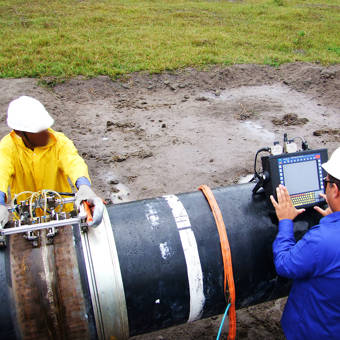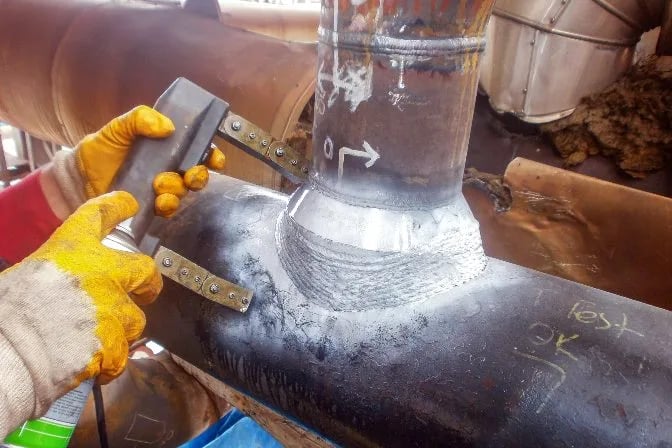Safeguard Your Financial Investment: Thorough Pipeline Welding Inspection for Comfort
Wiki Article
Comprehensive Introduction of Pipe Welding Evaluation Treatments
In the realm of pipeline construction, making certain the stability and security of welded joints is vital. Pipeline welding evaluation treatments play an essential function in guaranteeing that welded connections meet rigid market criteria and specs. From precise pre-welding inspections to comprehensive post-weld evaluations, a distinct examination process is important for preserving the structural soundness of pipes. Recognizing the intricacies of welding examination treatments is not only a governing need however also a fundamental facet of supporting the reliability of these crucial facilities.Pre-welding Inspection Preparations
Before commencing the welding procedure, thorough pre-welding examination preparations are crucial to ensure the stability and high quality of the weld joint. These preparations involve a thorough evaluation of the materials to be welded, the welding equipment, and the work atmosphere. Firstly, the products should be inspected for any kind of defects, pollutants, or inconsistencies that could compromise the weld. This consists of checking for proper product qualities, dimensions, and surface area problems. Pipeline Welding Inspection. Furthermore, the welding tools requires to be checked to validate that it remains in excellent working problem, calibrated correctly, and suitable for the specific welding process. Any type of issues with the devices ought to be attended to immediately to avoid issues in the weld. Last but not least, the work environment need to be reviewed for cleanliness, appropriate ventilation, and security actions to ensure a helpful setting for the welding operation. By conducting extensive pre-welding examination prep work, potential problems can be determined and resolved early, leading to high-quality and dependable weld joints.Welding Procedure Certification
Extensive pre-welding evaluation prep work lay the foundation for the critical procedure of Welding Treatment Certification, guaranteeing the integrity and quality of the weld joint. Welding Treatment Qualification (WPQ) is a vital step in the welding procedure that involves testing and certifying welding procedures to ensure they fulfill specific criteria and demands. The WPQ process usually includes welding procedure specification growth, welding procedure credentials testing, and paperwork of the results.Throughout welding treatment spec growth, essential details such as the welding process, welding materials, joint layout, and welding criteria are specified to develop a comprehensive treatment. Consequently, welding procedure certification testing is performed to validate the recommended procedure's honesty. This testing frequently includes welding test promo codes that undergo various mechanical and non-destructive examinations to examine the weld's high quality and adherence to the specified standards.
In-process Weld Evaluation
Throughout the welding procedure, in-process weld evaluation plays an important role in ensuring the high quality and integrity of the weld joint - Pipeline Welding Inspection. This kind of evaluation includes keeping track of the welding specifications, assessing the weld grain development, and discovering any kind of potential flaws or discontinuities as they happen. By performing in-process weld evaluations, welding operators can immediately deal with any type of issues that may emerge, therefore ensuring and preventing more flaws that the final weld meets the called for requirementsUsual approaches used for in-process weld assessment include visual evaluation, liquid penetrant screening, magnetic fragment testing, ultrasonic testing, and radiographic screening. Overall, in-process weld assessment is essential for preserving the top quality and reliability of bonded pipes.
Non-destructive Testing (NDT)
Non-destructive Testing (NDT) is an essential method utilized in pipe welding inspection to evaluate the honesty of weld joints without creating damage to the welded structure. By making use of numerous NDT techniques, examiners can review the top quality of welds and determine any type of issues or suspensions that may endanger the structural strength of the pipe. Usual NDT methods made use of in pipeline welding assessment consist of Radiographic Screening (RT), Ultrasonic Testing (UT), Magnetic Bit Checking (MPT), Fluid Penetrant Screening (LPT), and Visual Testing (VT)RT includes making use of X-rays or gamma rays to generate images of the inner structure of the weld, permitting assessors to discover problems such as porosity, fractures, or insufficient blend. UT uses high-frequency audio waves to find imperfections under the surface of the weld, providing in-depth information regarding the dimension and place of issues. MPT and LPT are utilized to determine surface-breaking flaws by using penetrant fluids or magnetic bits to the weld area. Furthermore, VT involves visual examination of welds to recognize any kind of visible blemishes.
Post-weld Assessment and Paperwork


Paperwork of post-weld examination searchings for is essential for preserving high quality control records and ensuring conformity with market requirements and regulations. Thorough reports ought to consist of information about the examination approaches utilized, the location and nature of any kind of flaws discovered, and any kind of rehabilitative actions taken - Pipeline Welding Inspection. Appropriate documents not just functions as a record of the weld's high quality yet likewise aids in future maintenance and inspection processes
Conclusion

In verdict, pipe welding evaluation treatments play an important duty in guaranteeing the top quality and integrity of welds. company website Overall, adherence to appropriate examination methods is vital to the success of pipeline welding tasks.
From careful pre-welding inspections to comprehensive post-weld analyses, a distinct evaluation procedure is vital for maintaining the structural soundness of pipes. By carrying out in-process weld inspections, welding drivers can immediately deal with any type of issues that might emerge, thereby making sure and protecting against further issues that the final weld meets the called for specs.
Usual techniques utilized for in-process weld inspection include visual assessment, liquid penetrant screening, magnetic fragment testing, ultrasonic screening, and radiographic testing.Non-destructive Testing (NDT) is an essential method used in pipe welding assessment to assess the honesty of weld joints without triggering damages to the welded framework. Post-weld evaluation entails different approaches to analyze the welds for issues, including visual examination, dye penetrant screening, magnetic see here now bit testing, ultrasonic testing, and radiographic testing.
Report this wiki page